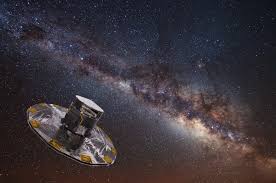An international consortium led by FAU astronomers discovered three hyper-velocity stars (HVS), which survived supernova explosions. These “Zombie” stars could give clues concerning how the chemical elements are created and distributed in the Universe. Not only a new class of HVS has been discovered, but also a new physical slingshot mechanism to eject the stars has been uncovered.

Artists impression of the Gaia satellite measuring the stars of the Milky Way. (c/o: ESA/ATG medialab/ESO/S. Brunier)
First discovered in 2005, hyper-velocity stars move through space at such a high speed that they will escape from the Galaxy. Despite an intense search no more than two dozen HVS have been discovered up to now. How these stars gain their enormous momentum to overcome the gravitational attraction of the Galaxy is still under discussion. “The most popular explanation is, that the monster black hole in the centre of the Milky Way disrupts a binary star that comes too close”, Prof. Dr. Ulrich Heber from FAU’s astronomical institute, one of the discoverers of the first HVSs, says. “More recent investigations, however, have shown that there have to be alternative slingshot mechanisms to explain the diversity of HVSs.” his FAU colleague, Dr. Andreas Irrgang, adds.
A new class of star discovered
The Gaia space observatory of the European Space Agency (ESA) has paved the way to understand the origin of HVS. Gaia’s astrometric data, published in April 2018, allowed for the first time the three dimensional trajectories of HVS through the Milky Way to be calculated and the place of origin to be identified. FAU astronomer, Dr Roberto Raddi, cross-matched the Gaia data with other astronomical catalogs to search for new HVSs and made an astonishing discovery: two new HVS that are strikingly similar to the exotic HVS, LP 40-365, netted serendipitously two years before by another team. An international collaboration consisting of astronomers from ten universities, in Germany, the UK, USA, and Italy carried out an extensive observational campaign with large telescopes, including the Hubble Space Telescope and the European Very Large Telescope: A new class of star was found.
The chemical composition is unique
The most important result was the uniquely peculiar composition of the new stars. They consist mostly of neon and oxygen. No trace of hydrogen and helium were detected, which are the dominant constituents of normal stars like the Sun. How is this possible? “Explosive thermonuclear explosions, such as in a hydrogen-bomb, may transform light chemical elements into heavier ones by nuclear fusion.” Dr Roberto Raddi explains. “Indeed, this has been proven to happen in thermonuclear supernovae caused by the explosion of a so-called white dwarf, an Earth-sized degenerate star. A white dwarf may explode if it accretes matter from a companion star”, he adds.
Zombie stars survived Supernovae

Two hyper-velocity star ejected in a supernova explosion.
Did FAU astronomers detect zombie-dwarfs, survivors of supernovae? Previous numerical simulations suggested that such an explosion would destroy the white dwarf completely. The former companion would be left behind and then ejected at hyper-speed. New models, however, revealed that in specific conditions the white dwarf is not entirely disrupted. About 20% of the mass may remain and form this exotic type of object, which is predicted to consist of neon, oxygen, magnesium, aluminum, and heavier elements, like manganese, iron, and nickel.
The observed abundances of these chemical elements of the new class of star are exactly what is predicted by the numerical simulations. But it remained unclear, why these relics of a stellar death contain no carbon, which they should have according to the numerical models. “This is one of the open questions, still to be answered”, Roberto Raddi says.
Supernova explosion create a HVS pair
How is the white dwarf relic ejected – and what will happen to the companion star? The researchers came up with a plausible explanation. The stellar companion had to be very close to the white dwarf for mass to be transfer to the latter, which required both stars to orbit their common centre of mass at extreme velocities. When the white dwarf exploded, it received a kick so strong to unbind the binary, causing both partners to fly out in different direction at hyper-speed. “Actually, two hyper-velocity stars were launched at the same time.” Ulrich Heber concluded. “Unfortunately, it will be very difficult to find the former companion star to any of the zombie dwarfs, because according to our estimates the ejection happened already 40 million years ago.”
The team succeeded to discover a new class of HVS as well as to uncover a new physical slingshot mechanism for HVS.
The results are accepted for publication in the renowned scientific journal Monthly Notices of the Royal Astronomical Society (https://academic.oup.com/mnras/advance-article/doi/10.1093/mnras/stz1618/5521904 or https://arxiv.org/pdf/1902.05061.pdf)
The journal Nature reported the paper as a research highlight:
https://www.nature.com/articles/d41586-019-02083-9
Additionally, an article about the results is also published at SPIEGEL Online: https://www.spiegel.de/wissenschaft/weltall/forscher-entdecken-zombie-sterne-in-der-milchstrasse-a-1276102.html
For further information please contact:
Roberto Raddi
roberto.raddi@fau.de
+49 951 95222 16
Ulrich Heber
Ulrich.Heber@sternwarte.uni-erlangen.de
+49 9131 85-81014


